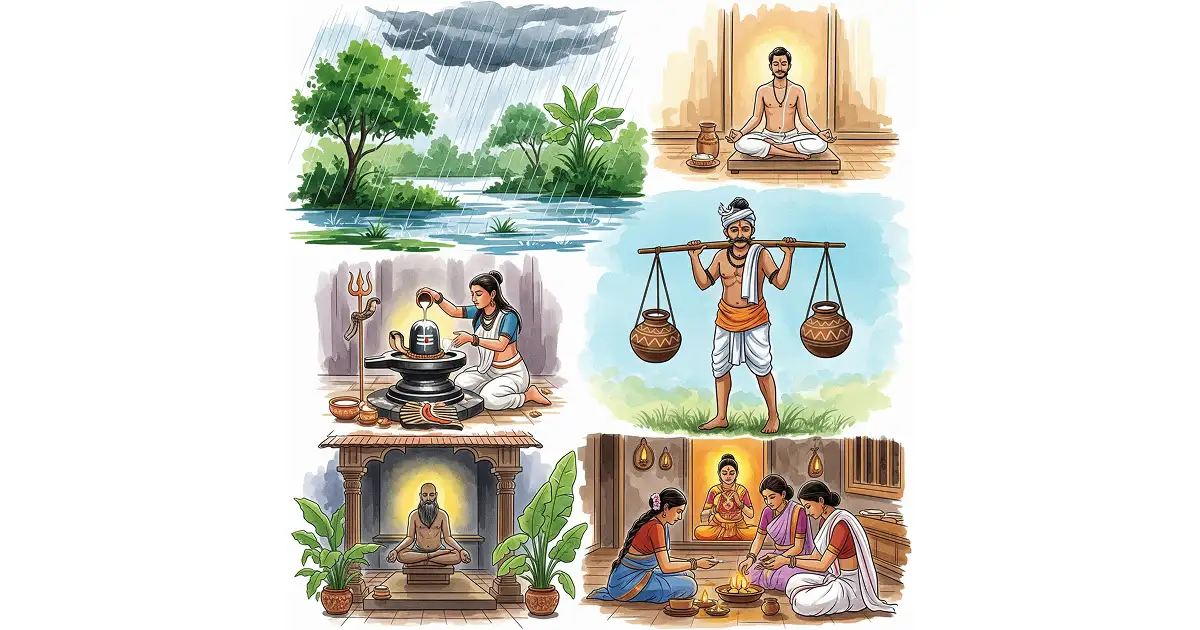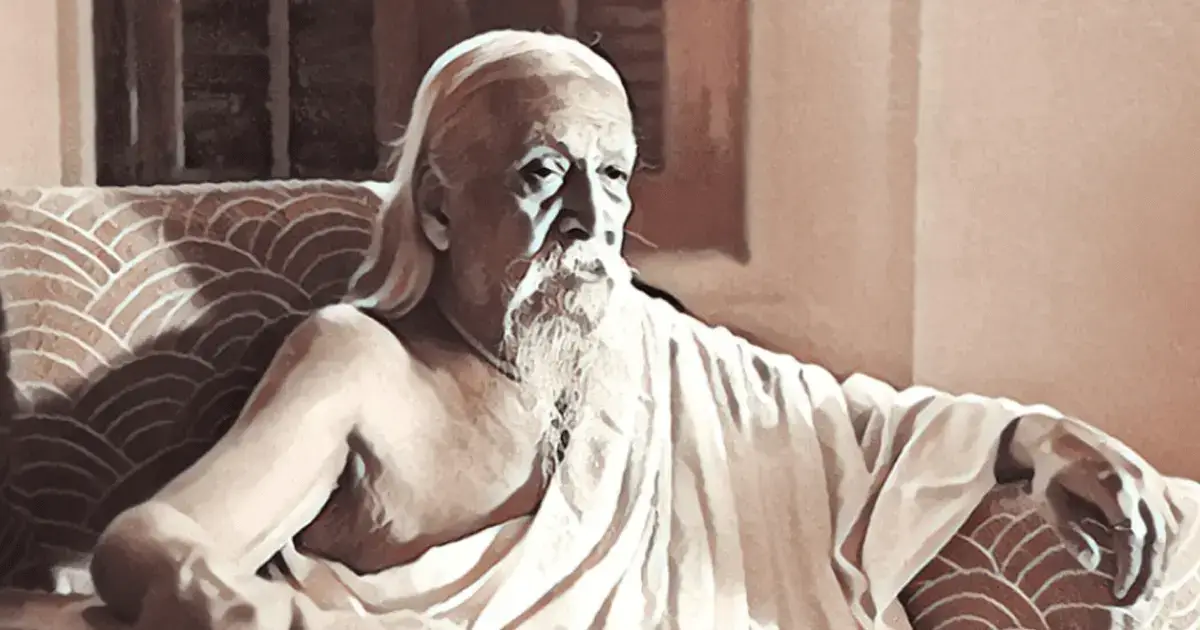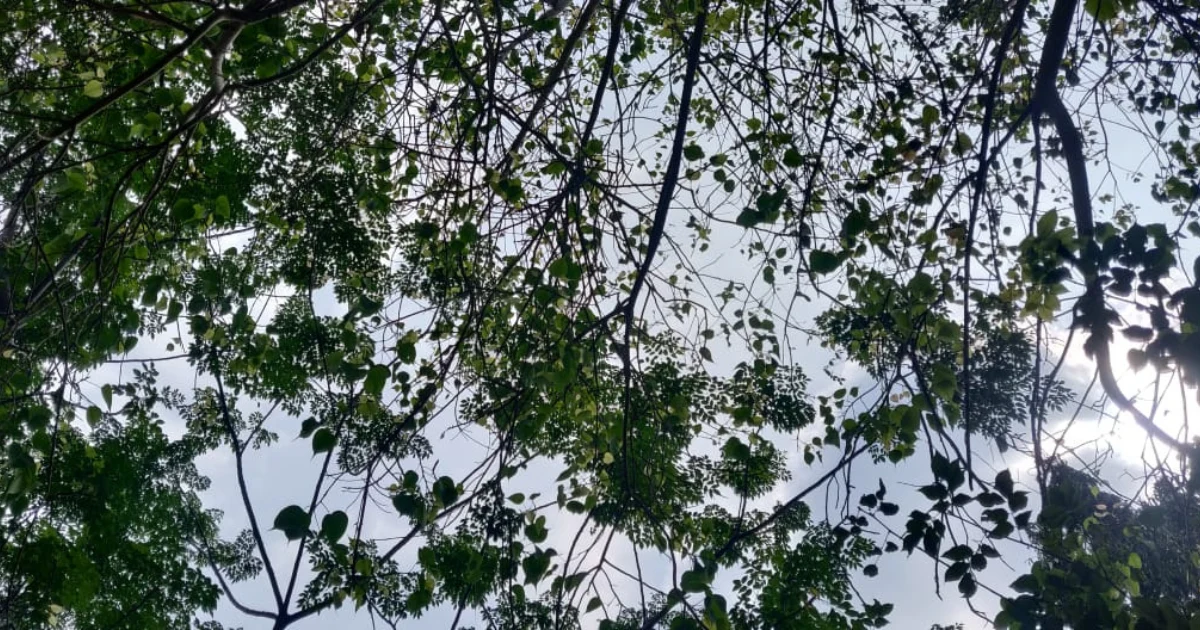Introduction
The lunar month of Śrāvaṇa (mid-July to mid-August) occurs when the full moon is in the Śravaṇa nakṣatra (the birth star of Lord Śrīdhara/Viṣṇu), and therefore, he is the presiding deity of this month.
Śrāvaṇa māsa brings with it the generous south-west monsoons, a life-giver and a blessing for crops. It begins with the Cāturmāsa period (when Vișṇu sleeps) – considered an immensely auspicious period for undertaking spiritual austerities since ‘bhole bābā’ (Lord Śiva) takes over, and he is known to be easily pleased, and thus, grants boons generously.
It is said that the start of the rainy season is also when ‘kāmuktā’ bhāva becomes active, and as we all know, Lord Śiva conquered Kāmadeva and burnt him to ashes. Therefore, this is also one reason that Lord Śiva is the one to be prayed to during this month.
This is also a month marked by numerous major festivals, including Janamāṣṭamī, Rakṣā Bandhana, Nāga Pañcamī, Pavitropanā Ekādaśī, and Kāmikā Ekādaśī, among others.
Mondays in this month are exclusively devoted to Lord Śiva and Tuesdays to Mā Pārvatĩ.
It is believed that this was the very month when Lord Śiva bestowed his grace on Mārkaṇḍeya, the son of Mṛkaṇḍu ṛṣi, who was destined to die in his teenage years, but since he prayed fervently to Lord Śiva, he conquered death and went on to compose the Mahāmṛtyuñjaya mantra with the Lord’s blessings.
Therefore, people worship Lord Śiva for a long life during this month. Devotees follow a strict vegetarian diet, abstaining from onion and garlic, and observe fasting on specific days.
A Non-Śāstrika perspective
The Śrāvaṇa month kicks off the full-fledged rainy season. It is a period of fertility and procreation activities that take place in nature and all living beings.
The prohibition on the consumption of non-veg is also because animals are in their procreation phase, and nature needs to be given time to recuperate and recreate. Roots like garlic and onion are also discouraged from consumption, as we see situations like waterlogging in many places, and this stagnant water can give rise to the rapid birth of bacteria during this fertile period, which could seep into the ground, causing harm to underground vegetation.
As per Āyurveda, milk is also not recommended during this period due to the high chances of it curdling due to the increased activity of microorganisms during this period. Also, milk, which is loaded with fats and proteins, becomes a little difficult to digest during this sluggish period and can lead to gastrointestinal as well as mucus-induced discomfort. Plus, cows that are prone to getting unwell during this period can pass on pathogens. Therefore, one can see an abundance of milk available, which is available during this period for ritualistic purposes.
Fasting is also a good way to keep the digestive tract in good shape, as this is a season when one falls sick easily, as metabolism, as well as immunity, are said to be generally slower and lower than other times of the year.
In earlier times, this rainy season would have come along with a lot of travel restrictions, so people would generally have been confined to homes, leading to a period of rest and reconnection with society and family etc. One needed to remain calm and composed, and not give in to unrestricted pleasure due to the lovely environment all around.
Therefore, it was advised to regulate one’s desires and emotions by investing time into activities connected to spiritual upliftment, study as well as listen to auspicious words and sayings (Śravaṇa means ‘to hear’), perform sacred rituals, and do charity which can help those who were unsheltered in this rainy season.
Scriptural References
phalavratī caturmāsaṃ phalaṃ tyaktvā pradāpayet || 5 ||
śrāvaṇādicaturmāsaṃ vrataiḥ sarvaṃ labhedvratī |One who rejects fruit for four months, commencing with śrāvaṇa and gives (the fruits) as a gift would get everything.
Agni Purāṇa, Chapter 198 - Vows performed in different months (māsa-vrata)mahādeva uvāca |
śrāvaṇe māsi saṃprāpte pavitrāropaṇo vidhiḥ |
yasminkṛte tu deveśi divyabhaktiḥ prajāyate || 1 ||Mahādeva said: When the month of Śrāvaṇa comes, the rite of the investiture of the sacred thread should be performed, having done which, divine devotion is produced.
Padma Purāṇa, Chapter 86 - The Investiture of the Sacred Thread (Upanayana)पूर्वो अयम् वार्षिको मासः श्रावणः सलिल आगमः |
प्रवृत्ताः सौम्य चत्वारो मासा वार्षिक संज्ञिताः || ४-२६-१४
न अयम् उद्योग समयः प्रविश त्वम् पुरीम् शुभाम् |This is the month of Sravana, first of those that see the rain-clouds burst. Four months, thou knowest well, extends the season when the rain descends. No time for deeds of war is this.
Rāmāyaṇa, Book IV - Kiṣkindhā Kāṇḍa - Chapter 26श्रावण्यां प्रौष्ठपद्यां वाऽप्युपाकृत्य यथाविधि ।
युक्तश्छन्दांस्यधीयीत मासान् विप्रोऽर्धपञ्चमान् ॥ ९५ ॥Having performed the “Upākarma” (starting rite) on the full-moon day in the month of Śrāvaṇa or of Bhādrapada, the Brāhmaṇa shall, with due diligence, study the vedas, according to rule, during four months and a half.
Manusmṛti, Verse 4.95Manusmriti here explains why this month is known by the name Śrāvaṇa, also because it is the time for studying the Vedas (śruti), which is oral and is to be heard (śravaṇa) from the preceptor and learnt.
Major Festivals Observed
Śrāvanīya Somavāra Vrata
It is observed to please Lord Śiva and receive boons. Unmarried girls keep ‘Solah Somavāra’ vrata (for the entire Cāturmāsa Mondays) for a husband like Lord Śiva, as it is believed that Mā Pārvatī had kept these vratas to obtain Śiva as a husband.
Kanwar Yātrā
Kanwar (a wooden pole carrying two equal containers of Gaṅgā jala, collected from various pilgrimage sites, on both ends) yātrā is undertaken during this month. The Kanwar yātrā is associated with the legends of the Samudra manthana episode, when Lord Śiva consumed the Halāhala poison for the benefit of the world.
Pilgrims undertake a month-long journey to collect Gaṅgā jala from pilgrimage sites like Gaṅgotrī and Haridvāra, among others, and return home to offer it to their local Śiva liṅga in a temple that they have tremendous faith in, in their hometown. The Kanwar (pots), once filled with Gaṅgā jala should never touch the ground, and devotees are to walk barefoot throughout the journey.
Therefore, one sees special stands made by good samaritans along the way for devotees to rest their kanwar while they take a little rest.
It was performed mostly by saints and spiritual ascetics from an unknown time, but gained a public following from the 1960s to the 1980s.
It is believed that in Tretā Yuga, Śiva’s devout follower Rāma brought holy water of Gaṅgā by using a kanwar and poured it on Śiva’s temple in Purāmahādeva in Purā, Uttar Pradesh. Thus, releasing Śiva from the negative energy of the poison.
Maṅgalā Gaurī Vrata
The Maṅgalā Gaurī Vrata is mainly kept by married women on Tuesdays of the Śrāvaṇa month, for the longevity of their husbands. Unmarried girls also observe this fast to get their desired husband and prosperity in life.
The Story Behind Maṅgalā Gaurī Vrata - A merchant named Dharampal had a very beautiful wife and was wealthy. But, they were unhappy as they were childless. In due time, by the Lord’s grace, a son was born who was destined to be short-lived and would die by a snake bite at the age of sixteen. In order to thwart this, he was married before he turned sixteen to a girl whose mother observed the Maṅgalā Gaurī Vrata, and he lived till a hundred years.
After hearing the tale, married women offer 16 laddoos to their mother-in-law and sister-in-laws. Thereafter, they offer the prasāda to a Brahmin. After completing this ritual, devotees perform Nirajan (ārtī) of the 16-wick lamps before the Goddess. The next day, i.e., Wednesday, the idol of Devī Maṅgalā Gaurī is immersed in a pond or lake. This pūjā and vrata are performed for five consecutive years for the happiness of the family.
Haryālī Teej/Śrāvaṇa Teej
This falls on śukla pakṣa Tṛtīya (Teej) of the Śrāvaṇa month, celebrating the day when Śiva gave in to goddess Pārvatī's wish to marry him. Pārvatī is also known as Teej Mātā/mother of the Teej (Tṛtīya), as we can also see this mentioned in the Padma Purāṇa verses listed above, that she’s the Goddess of Tṛtīya tithi. On this day, a fast and pūjā are performed for one’s husband’s long life, which means a happy conjugal life, by married women who then visit their parents and enjoy the day with friends and festivities. Women particularly wear green and orange clothes and apply henna on their hands and feet to mark the occasion, along with festivities of swinging under the trees and men and boys flying kites.
The tradition of Kothali (Sawan ki Kothali) has been going on in Haryana for centuries. Under this tradition, in the month of Śrāvaṇa, the brother goes to his sister's in-laws' house with a gift of sweets. After marriage, the girl must spend the first sawan at her maternal side. In the first sawan, the girl's kothali is sent by the in-laws. After that, every year in the month of sawan, the kothali goes from the woman's maternal home to her in-laws' house.
Sawan ki Kothali is also known as Teej ki Kothali and Sawan ke Sindhare. Firni and Ghevar are the main sweets. The speciality of these sweets is that they are made only in the month of Śrāvaṇa. It occurs during the monsoons, so everything around us in nature is at its greenest.
It is mainly celebrated (in a similar fashion) across the north Indian states of Punjab (Teeyan), Haryana (Teej), Rajasthan and the Harela festival in Kumaon. In Kumaon, the locals sing the following lines in the Kumaoni language:
Ji raiya, jagi raiya, tisteya, panpiya,
Dub jaisi hari jad ho, byar jas phaiye,
Himalaya me hyun chan tak,
Ganhjyu me pani chhan tak,
Yo din or yo mas bhetne raiya.
The lyrics translate to - Live long, be lively, may your family and lineage prosper and remain evergreen like crops. May your life expand as much as the earth, and reach the sky. May you live till the time there is snow on the Himalāya and the Holy Gaṅgā and Yamunā flow from it. May this day and month keep coming throughout your life.
Varalakṣmī Vratam
Lakṣmī is the protector of married women. This vrata is undertaken by married women in south India on the Friday following Pūrṇimā to propitiate Devī Lakṣmī for blessing them with a vara for eight types of wealth (Aṣṭalakṣmī), along with the family’s well-being. Outside the main door a tray is set up on a wooden platform and a ‘kalaśam’ of brass/silver is placed on it, which is a representation of the Devī. Fruits, flowers and sweets are offered to a ‘kalaśam’ and it is decorated with a saree, mango leaves, kumkum, sandalwood paste and gold jewellery.
Auspicious items such as rice, betel leaves, turmeric sticks, bananas and coins are placed inside it. A thread dipped in turmeric is tied around the neck of the kalaśam, and a coconut scrubbed with turmeric is placed over it.
Auspicious bhajans are sung to it, and the tray is then carried into the pūjā room. A lamp is lit, āratī and ślokas are performed. The yellow thread is then distributed piece by piece to each female to tie around their wrist. Charity is to be done after this.
In Tamil Nadu, it is a day to prepare varieties of dishes for the naivedyam (offering). Along with cooked food, flowers, fruits and betel leaves, items suitable for ‘śṛṅgāra’ of married women are offered to the women who participated. Nine varieties of dishes, nine items for gifts to the married women and nine married women should be gifted these. Indian traditions place a lot of emphasis on numbers - even numbers signify completeness, and odd numbers signify growth.
The kalaśam is then placed inside a drum full of rice, with all its contents within, for the goddess to rest until next year. Purchase of gold is also advised on this day.
Vrata Kathā
In the kingdom of Kosala, a Brahmin woman named Padmāvatī was known to be pious and dutiful, as well as reputed for helping the needy. Goddess Lakṣmī had been observing her. The Goddess asked her to perform this vrata on this day in the month of Śrāvaṇa to achieve salvation.
Another version is about a virtuous woman named Cārumatī, who has a dream of Viṣṇu, instructing her to worship goddess Lakṣmī every year during the month of Śrāvaṇa, which will bless her and her family with all kinds of wealth and prosperity.
Nāga Pañcamī
Brahma Purāṇa (3.96-101) - Kadru gave birth to thousand Nāgas, the chief of whom were Śeṣa, Vasuki, Takṣaka, Airāvata, Mahāpadma, Kambhala, Aśvatara, Elapatra, Saṅkha, Karkotaka, Dhanañjaya, Mahānīla, Mahākarṇa, Dhṛtarāṣṭra, Balahoka, Kuhara, Puśpadamstra, Durmukha, Sumukha, Sarkha, Sankhapāla, Kapila, Vāmana, Nahuṣa, Sankharoma, Maṇi and a thousand others.
Śeṣa maintains the gods, the asuras, all the beings, and all the ‘tamasa’ form of Lord Viṣṇu.
Skanda Pūrāṇā’s Verse 73 of Chapter 2 of Book 8 - On the fifth day in the bright half of the month of Śrāvaṇa a grand festival with serpents in view, with the worship of Śeṣa as the main function, should be celebrated with great effort by good people. If Brahmins are devoutly propitiated along with the worship of serpents, all the serpents will become delighted and will never harass men.
Kāmikā Ekādaśī
Padma Purāṇa – Ch. 54 – Uttara Khaṇḍa - Mentions that one does not obtain that fruit (by bathing) in Gaṅgā, at Kāśī, Naimiṣa or Puṣkara, which he gets by worshipping Kṛṣṇa on this day (which falls in the Kṛṣṇa pakṣa). Both he who gives the earth along with the oceans and he who observes the kāmikā-vow are said to get the same fruit. The man who observes the kāmikā-vow obtains the fruit which he who would give a milch cow along with articles of household use, gets. The excellent man who would worship god Viṣṇu in Śrāvaṇa, has worshipped gods with gandharvas, uragas and pannagas. The kāmikā-vow is best for the emancipation of those who are plunged in the ocean of worldly existence, full of the mud of sins. Viṣṇu himself has said (so). The man who, after having kept awake at night, observes the kāmikā-vow does not see the fearful Yama, or does not face a calamity. He does not see (i.e. is not born in) a bad stock due to his observing the kāmikā-vow. The meditating saints have reached final emancipation after observing the kāmikā-vow.
The man who would worship Viṣṇu with tulasī-leaves is not tinged with sin, as a lotus leaf with water. Citragupta is not able to know the measure of the religious merit of the man who gives (i.e. keeps) a light day and night on the day of Viṣṇu (i.e. on the day sacred to Viṣṇu). The dead ancestors of him whose lamp burns in front of Viṣṇu, remain in heaven and are gratified with nectar. Having burnt a lamp with ghee or sesamum oil, he, being honoured with a hundred crores of lamps, goes to the Sun’s world. It removes (the sin of) the murder of a brahmin, which removes (the sin of) causing abortion. It gives them the abode of Viṣṇu, and gives the fruit of great religious merit.
Pavitropanā Ekādaśī
Padma Purāṇa – Uttara Khaṇḍa – Ch. 55 - Mentions the tale of a king named Mahījit who, at the beginning of Dvāpara age, in the city of Māhiṣmatī, ruled over his kingdom. He was unhappy as he had no son. His head-priest and other brahmins went to a dense forest, desiring the well-being of the king, to meet the best sage Lomaśa, who was practising a severe penance.
The sage told them about the king’s previous birth, where he was a poor vaiśya and committed evil deeds. He once went to drink water from a pond and selfishly chased away a cow with her calf, who was very thirsty too. And due to that sinful act, the king became sonless. However, due to the religious merit of his (former) birth, he obtained the kingdom free from nuisance.
The sage advised that the king should observe the Ekādaśī, which falls in the bright half (śukla pakṣa) of Śrāvaṇa, is called Putradā, and gives desired objects.
The queen conceived after the king performed the vrata and gave birth to a son later.
Śrāvaṇa Śivarātri
Celebrated on the 14th day of Kṛṣṇa Pakṣa (Caturdaśī tithi). Mostly specific to the north Indian regions. Devotees observe a day-long fast and offer bilva leaves, milk, and water to Śiva. It’s a part of the Kanwar yātrā tradition.
Conclusion
Śrāvaṇa māsa is a time for growth and creation, both spiritually as well as materially, as nature is fertile and procreating during this monsoon period. One gets manifold rewards for all their good deeds done during this period. There are multiple reasons for the festivals in this month, celebrating conjugal bliss, as this is a fertile time for nature and all living beings.
Please note - Janamāṣtamī and Rakṣā Bandhana would be covered in separate articles dedicated solely to each, and to be published on their respective dates.
References and Recommended Readings
-
Narada Purāṇa (abridged)
-
Agni Purāṇa
-
Padma Purāṇa
-
Vālmīki Rāmāyaṇa
-
Manusmṛti
-
Skanda Purāṇa
-
Putradā Ekādaśī
Material Acts in Everyday Hindu Worlds By Joyce Burkhalter Flueckiger
Hindu Prayers, Gods and Festivals By Tumuluru Kamal Kumar
The Book of Vishnu By Nanditha Krishna
South Indian Hindu Festivals and Traditions By Maithily Jagannathan
Folk Tales of Gujarat (and Jhaverchand Meghani) by Vandana P. Soni







